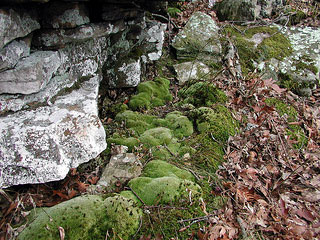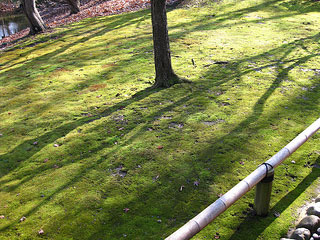Resource Library
Plant of the Week: Moss

GREEN -- Moss is at its best in the winter. (Image courtesy Gerald Klingaman)
Moss
Latin: Mostly Leucobryum
Walking in the woods during an Arkansas winter leaves me looking for anything green.
Most often I find myself zeroing in on clumps of moss, for they are always present
and rewarding if you are willing to zoom in and appreciate nature on a Lilliputian
scale.
Botanists classify the 12,000 species of moss as bryophytes. These are primitive plants
with their origins tracing back about 470 million years, making them one of the first
land plants. They didn’t conceive photosynthesis but ancient moss ancestors were the
species that brought it from the tidal pools on the edges of earth’s oceans to dry
land.
Mosses have leaves and stems and a rudimentary kind of root system, called a rhizoid,
but it is mainly used for anchoring the plant in place, not taking up water and nutrients.
Moss leaves are a single cell thick and lack a protective epidermis, making them dependent
on the moisture content of their environment to maintain their turgidity. Because
of this reliance on ambient moisture conditions they are most often found in moist,
shaded locations. In the wintertime they flourish because the cooler temperatures
reduce water loss and the humidity – a function of temperature and the amount of moisture
in the air – often approaches 100 percent.

LAWN -- This moss lawn at the Missouri Botanical Garden in St. Louis must be swept often to keep leaves from killing out patches of moss. (Image courtesy Gerald Klingaman)
Moss leaves, themselves often quite tiny, are spirally arranged around the tiny stems
which contain the earliest known example of a vascular system. Mosses were long thought
to not contain a vascular system but it is now known that theirs is in a non-lignified
form, unlike the hardened tubular conductive tissue of higher plants.
Mosses usually grow perched atop a rock, board or the base of a tree. Water and nutrient
essentials come in the form of rainfall or dew and wind borne debris. If the rainfall
doesn’t come in a timely manner, the plant shrivels up and looks dead, only to revive
quickly when rehydrated. Mosses are tough – some have been revived after storage for
over a century in a dry herbarium cabinet.
But the biggest feature differentiating these primitive plants from higher plants
is how they reproduce. They reproduce by spores like ferns but their mode of reproduction
is so very different. In higher plants, including ferns, and in animals, the normal
compliment of chromosomes in the cell nucleus is a paired set of two chromosomes (the
2n or diploid state), one each derived from the male and female parent. Only during
reproduction does the chromosome strand separate into a single, independent state
(the 1n or haploid state).
Mosses do it differently. The moss plant exists with single, unpaired chromosomes
(the 1n state) and only unites with a compatible partner during reproduction to create
the 2n phase. The 2n zygote then matures and undergoes meiosis before releasing 1n
spores from the reproductive capsules.
Many mosses have worldwide distribution and are found on all continents. This speaks
of their ancient linage with many species being around when the continents were merged
as a single great land mass.
I’ve made several half-hearted attempts to identify my moss photos to the species
level but find it difficult -- well, perhaps impossible. Photos, unless taken with
great care and very close up, don’t record the kind of detail needed to identify mosses
to the species level. To do so with accuracy one needs a good live specimen – preferably
with capsules present, a well-illustrated regional field guide, a hand lens and a
lot of patience.
Mosses have been a part of garden design in Japanese and Chinese gardens for centuries
but it has only been in the past couple decades that moss gardening has taken root
in this country. They can be grown on the ground like any groundcover but if they
are in an area that gets covered with leaves or where weeds grow well, they usually
will not survive. They are especially well suited for use between stepping stones,
on north facing slopes or cool shaded nooks, but weed completion and leaf litter must
be carefully watched.
Hand sprinkling will keep them sufficiently moist during most of the year but in summer
months extra care will be needed to keep them from going dormant. The best choice
of adapted moss is to find patches growing in your own garden and then transplanting
it to similar environmental niches in the garden.
By: Gerald Klingaman, retired
Retired Extension Horticulturist - Ornamentals
Extension News - January 17, 2014